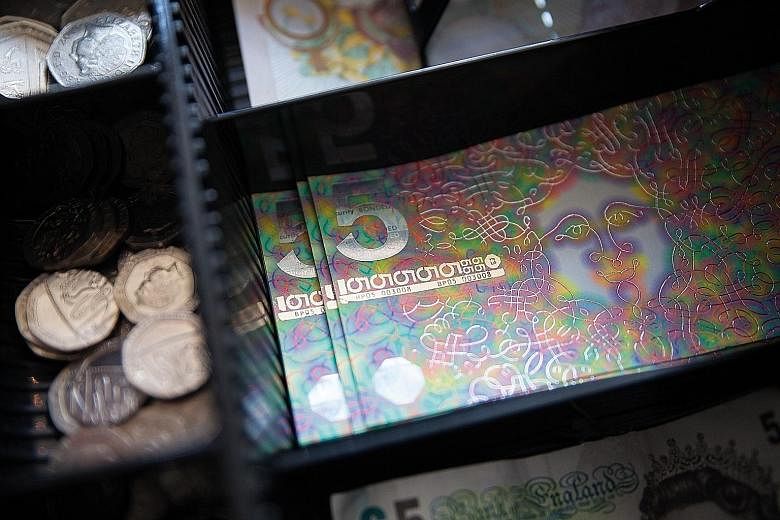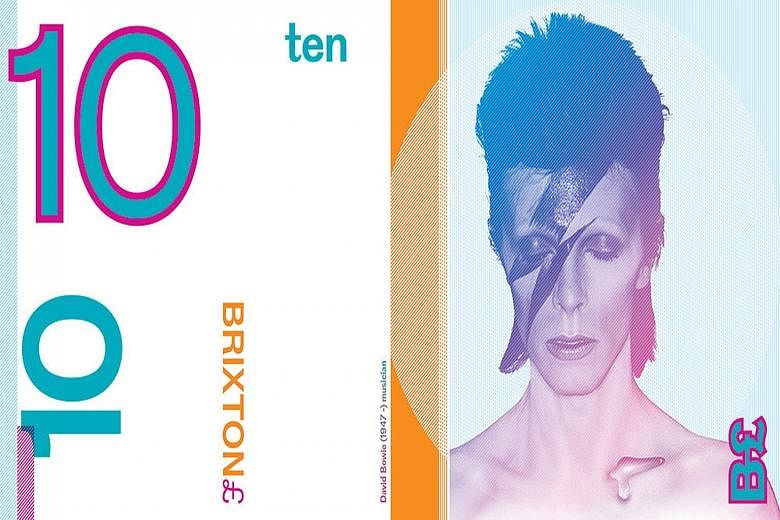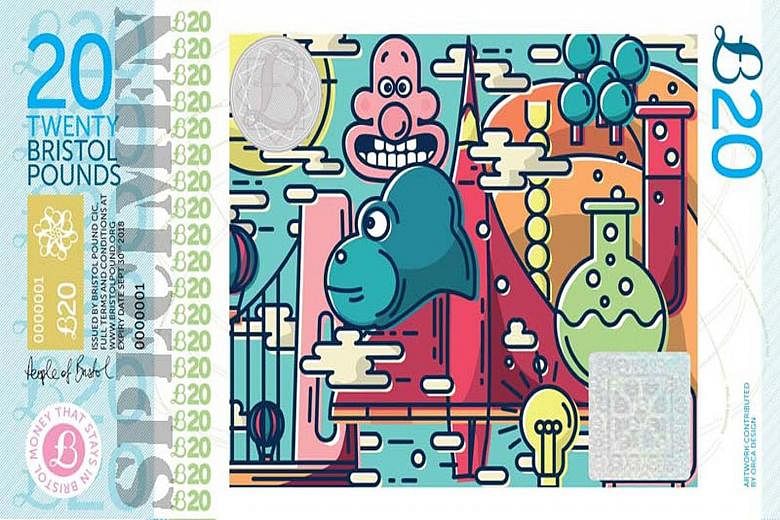LONDON • Though paper money here typically bears the visage of Queen Elizabeth, the Brixton district of the city last month released a new £5 (S$10.70) note designed by Jeremy Deller, an artist who won the prestigious Turner Prize in 2004.
It features a fuzzy, psychedelic image of an androgynous face surrounded by rainbow clouds and coruscating, swirling etchings.
"I wanted something old- fashioned-looking," the artist said. "Something almost pre-currency."
About 200km west of Brixton, in the city of Bristol, a pound note issued after a design competition that was open to locals displays a colourful lemur striding atop a vibrant cityscape. The back has magenta-hued, hand-cut stencil illustrations of accomplished denizens, including author J.K. Rowling and Dr Elizabeth Blackwell, the first woman to receive a medical degree in the United States.
As bitcoin, PayPal and other electronic forms of payment grow in popularity in the global economy, cash in a growing number of places - not only Bristol and Brixton, but also Amsterdam, New York's Ithaca and elsewhere - is becoming quite literally an artisanal object.
Many of the new alternative currencies have the look and feel of the regular legal tender accepted at such places. Most include anti- counterfeiting measures such as holograms and serial numbers. But they are more eye-catching.
At the Effra Social, a Brixton pub, Mr Ewan Graham, 31, an architect, was impressed upon examining one of the district's special pound notes for the first time.
"I'd be more inclined to save money if it all looked like that," he said.
The back of the note displayed a Karl Marx quote about capital and its "occult ability to add value to itself". The £10 note, meanwhile, pictured David Bowie, a Brixton native (stardust, or other powdery substance, not included). It is easy to imagine such notes being fetishised as audiophiles do vinyl.
The local currency, though, is intended not as collectible but to encourage trade at the community businesses where they are accepted, rather than chain stores, where money taken in tends to flow out of town and into the coffers of multinational corporations.
"If you use a local currency, you keep the money local, and that has a 'lifts all boats' vibe to it," said David Wolman, the author of The End Of Money.
One success story has been the BerkShare, a currency used in the region of Great Barrington, Massachusetts. First issued in 2006, BerkShare notes were supported by research and development funding secured by the Schumacher Center for a New Economics.
The notes, of which nearly US$1 million (S$1.38 million) worth were printed and roughly $138,000 worth are in circulation, highlight historical figures, including civil rights activist W.E.B. Du Bois and artist Norman Rockwell, and showcase the work of local artists.
The bills themselves are adorned with pastoral landscapes, cavorting native fauna and still-life paintings of turnips, evoking the bucolic scenery of the region.
Ms Alice Maggio, the programme coordinator of BerkShares Inc, said: "The idea of creating a currency that has our landscape and our values right on the bill, that's creating a sense of place that we don't always have in America, particularly as we move towards a more globalised and homogenised culture."
One need look no further than the argument about which woman should be depicted on the new US$10 bill to realise that the symbolic and aesthetic value of paper currency can be nearly as meaningful to consumers as its quantified worth.
"When some people hold a bank note, it makes them furious about fiat money and the debt," Wolman said. "But for others, those symbols embedded in that paper mean a lot - the note conjures feelings of togetherness or nationalism - and the state wants you to have that feeling."
One perhaps surprising alternative-currency enthusiast is the former central banker Bernard Lietaer, who was an architect of the European Currency Unit, the convergence system among 12 currencies that led to the euro. Now a professor of money and sustainability at the Sorbonne in Paris, he believes that money is "an extraordinarily emotional object", the immense power of which he likens, psychologically, to sex.
Alternative currencies, he suggested, provide an "implicit incentive: I want to give priority to - and I'm willing to make an effort for - my region or community".
He suggested that Greece, currently in bailout talks, should create a complementary electronic currency that could be accepted for the payment of taxes and usable on a local basis. This secondary currency, which he called a "neo-drachma", could be usable via mobile phone ("every Greek family has at least one," he said) to purchase local goods and services, and could fluctuate against the euro.
"If a Greek person wants to buy a German car, he would have to buy it in euros, at the exchange on the currency that's accepted with the euro," he said. "At the same time, for a haircut? I don't see any reason to use euros."
Regardless of whether it can solve major debt crises, there is an appeal to smaller, homespun, physical money, starting with the greater privacy it affords.
"As the government and corporations try to soak up more information from consumers, there are still going to be people that adhere to the good old medium of handing over dollar bills to exchange for goods and services," said Mr John Bush, 31, a so-called liberty activist and the owner of Brave New Books in Austin, Texas.
"More people want to move away from mediums where the government can track your every purchase," he said, adding that he prefers bitcoin, barter or precious metals, though his store does accept credit cards.
Nonetheless, the use of traditional paper money is clearly on the wane. Perhaps these smaller, more attractive artisanal paper notes are merely last bursts of glory before it disappears entirely.
Though as Deller, the artist behind the latest Brixton pound, said: "As long as there are drug deals and criminality, there'll be a need for cash."
NEW YORK TIMES



